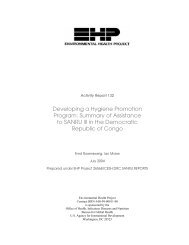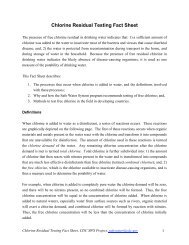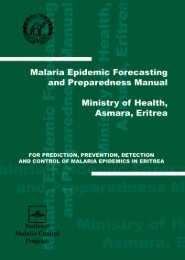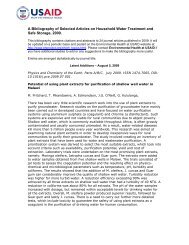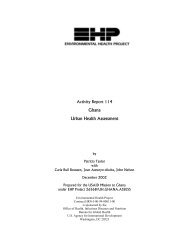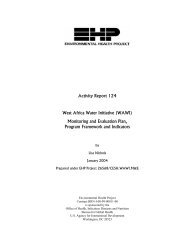Changing Glaciers and Hydrology in Asia - Environmental Health at ...
Changing Glaciers and Hydrology in Asia - Environmental Health at ...
Changing Glaciers and Hydrology in Asia - Environmental Health at ...
- No tags were found...
Create successful ePaper yourself
Turn your PDF publications into a flip-book with our unique Google optimized e-Paper software.
In general, the r<strong>at</strong>e of retre<strong>at</strong> <strong>and</strong>/or down-wast<strong>in</strong>g depends on several factors, <strong>in</strong>dependent ofdynamics. These <strong>in</strong>clude elev<strong>at</strong>ion, debris cover, ice thickness, <strong>and</strong> topographic slope <strong>and</strong> aspect;<strong>and</strong> not all <strong>in</strong>vestig<strong>at</strong>ors consider these variables when they report retre<strong>at</strong> r<strong>at</strong>es. Clearly, thegre<strong>at</strong>est retre<strong>at</strong> <strong>and</strong> or down-wast<strong>in</strong>g is associ<strong>at</strong>ed with those glaciers loc<strong>at</strong>ed <strong>at</strong> the lowestaltitudes on gentle slopes, with th<strong>in</strong> ice near the term<strong>in</strong>us, <strong>and</strong> the thickness of debris-cover th<strong>at</strong>enhances r<strong>at</strong>her than retards melt. Smaller glaciers <strong>at</strong> the lowest elev<strong>at</strong>ions with a southerlyaspect, <strong>and</strong> those “hang<strong>in</strong>g glaciers” cut off from a substantial accumul<strong>at</strong>ion area, will be the firstto disappear.Mass balance measurementsAs <strong>in</strong>dic<strong>at</strong>ed <strong>in</strong> Section 2.3, mass balance measurements subtract the amount of melt (abl<strong>at</strong>ion)from the amount of accumul<strong>at</strong>ion. A neg<strong>at</strong>ive result <strong>in</strong>dic<strong>at</strong>es th<strong>at</strong> the glacier is shr<strong>in</strong>k<strong>in</strong>g, apositive result th<strong>at</strong> it is grow<strong>in</strong>g. The unit of measurement is meters of w<strong>at</strong>er equivalent.WGMS (Zemp et al. 2008) reports an average global annual ice loss of almost 0.75 m of w<strong>at</strong>erequivalent s<strong>in</strong>ce 1997, twice as much as <strong>in</strong> the decade before (1988-1997) <strong>and</strong> three to fourtimes as much as the time period 1978-1987. However, a key fact to note here is th<strong>at</strong> virtuallyall of the glaciers <strong>in</strong> this global sample exist with<strong>in</strong> an elev<strong>at</strong>ion range th<strong>at</strong> is well below theaverage elev<strong>at</strong>ion of the Himalayan glaciers. For a review of mass balance monitor<strong>in</strong>g of the pastsix decades, see the recent public<strong>at</strong>ions by Zemp et al. (2009) <strong>and</strong> Lemke <strong>and</strong> Ren (2007).Mass balance records from Himalayan glaciers are extremely rare <strong>and</strong> of short dur<strong>at</strong>ion (Zempet al. 2009). Only records of ten or more years are relevant for clim<strong>at</strong>e <strong>and</strong> hydrologicalvariability <strong>and</strong> trend studies, <strong>and</strong> only two glaciers barely meet this threshold. Most glaciers arealso very small <strong>and</strong> loc<strong>at</strong>ed <strong>at</strong> low altitudes, <strong>and</strong> as such are not represent<strong>at</strong>ive of all Himalayaglaciers. D<strong>at</strong>a from the higher elev<strong>at</strong>ion Langtang <strong>and</strong> Chhota Shigri glaciers <strong>in</strong>dic<strong>at</strong>e consistentlyneg<strong>at</strong>ive mass balance values, but the extent to which they can be considered regionallyrepresent<strong>at</strong>ive is not known. The glacier AX010 <strong>in</strong> Nepal has been predicted to disappear by theyear 2060 if conditions represented by the period 1992-1996 rema<strong>in</strong> unchanged (Kadota 1997).This could be considered a reasonable prediction, given th<strong>at</strong> the size of this glacier is only 0.57km 2 . The uppermost altitude of AX010 is 5,360 m, while approxim<strong>at</strong>ely 50% of the surface areaof all Nepal glaciers exists <strong>at</strong> altitudes above 5,400 m, so AX010 can only be consideredrepresent<strong>at</strong>ive of the lower elev<strong>at</strong>ion glaciers (Alford et al. 2010).On the Yala Glacier, <strong>in</strong> Nepal, <strong>at</strong> a higher elev<strong>at</strong>ion than the Langtang, Fujita et al. (2006) haveconstructed a 30-year mass balance history from ice cores <strong>and</strong> the <strong>in</strong>spection of crevasse layers.They determ<strong>in</strong>ed th<strong>at</strong> the mass balance on the Yala Glacier <strong>at</strong> 5,380 m shows a positive balance,about 0.2 to 0.8 m, dur<strong>in</strong>g the period 1960 to 2000, tend<strong>in</strong>g towards zero <strong>in</strong> the mid-1990s. Alimited amount of melt was observed <strong>at</strong> 5,380 m on the Yala, while no melt was observed <strong>in</strong> thesame region <strong>at</strong> 7,200 m on the Dasuopu Glacier which is loc<strong>at</strong>ed on Mt. Xixabangma <strong>in</strong> Ch<strong>in</strong>a.No melt <strong>at</strong> this elev<strong>at</strong>ion would agree with the calcul<strong>at</strong>ions by Alford et al. (2010) describedbelow.Individual glaciers can respond with gre<strong>at</strong> variability to a chang<strong>in</strong>g clim<strong>at</strong>e. Therefore, it isimportant to <strong>in</strong>volve more regional-scale estim<strong>at</strong>es <strong>in</strong> the analysis of Himalayan glacier mass20





